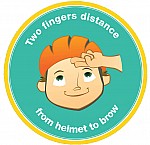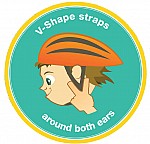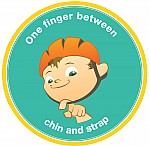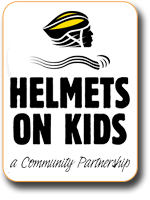201 King Street
London, Ontario N6A 1C9
Telephone: (519) 642-4539
info [snail] helmetsonkids [period] ca -> mailto:info [snail] helmetsonkids [period] ca
Home : Safety Information
Safety Information
On this page ... (Hide page listing)
How to Fit a Helmet
Remember to use the 2-V-1 rule so that you can make sure you are wearing your helmet properly every time you ride.



Preventing Injury isn’t brain surgery -
it only takes a moment to fit your bike helmet.
Prevention is the only cure!
It’s the law in Ontario for children and adolescents under 18 years old to wear an approved bicycle helmet. Be a good role model ... Wear your helmet when you ride your bike.
Helmet Fitting Demonstration
- you gently lift the back of the helmet up and forward, if it covers the eyes
- the child opens their jaw as wide as possible without moving their head, and the top of the helmet doesn’t pull down
- the helmet moves when they shake their head
Which Helmet, Which Activity?
The human skull is just three pennies thick. A properly fitted helmet can reduce the risk of serious head injury by up to 85%. Helmets are designed to absorb the force from a crash or a fall. This means that four out of five brain injuries could be prevented if every cyclist wore a helmet.
Helmets are constructed according to an understanding of how head and brain injuries occur in different activities:
- The brain is enclosed within a rigid skull
- The brain “sits” on bones that make up the base of the skull
- The spinal cord is attached to the brain and passes through a hole in the underside of the skull
- Under the skull, adhering to the skull bones is a tough tissue called dura that surrounds the brain
The best defense against injury is prevention. This doesn’t mean hibernation - it means getting trained, wearing the right gear and using your brain to navigate risks. Remember: visit http://www.parachutecanada.org/injury-topics/topic/C8 before you play!
Bicycle Helmet Standards
A sticker inside the helmet with the following indicates the helmet meets Safety Standards recognized in Canada:
- Wear and use helmets as recommended by the manufacturer.
- Helmets cannot prevent all head injuries in all sports.
- Some helmets are marketed as multi sport meet safety standards for more than one activity.
When to Replace Your Helmet
Replace you helmet when:
- You are in a crash
- You drop it hard on the ground
- The straps loosen when you are wearing it
- It has a crack in it
- The foam is falling apart
- If it is too tight on your head
- It is five years old (even if it is in great shape)
- Put stickers or decals on your helmet
- Wear a high pony tail, headphones, hats or ball caps
